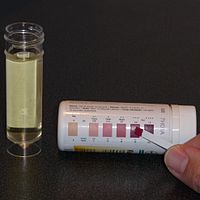
Photo from wikipedia
Obesity and male infertility are problems that affect population. Exercise is a nonpharmacological way to reduce the negative health effects of obesity. The purpose of this study was to examine… Click to show full abstract
Obesity and male infertility are problems that affect population. Exercise is a nonpharmacological way to reduce the negative health effects of obesity. The purpose of this study was to examine the effects of exercise on hormone levels, blood‐testis barrier, and inflammatory and oxidative biomarkers in rats that became obese due to a high‐fat diet (HFD). Male rats received a standard diet (STD group) or a HFD (HFD group) for 18 weeks. During the final 6 weeks of the experiment, swimming exercises (1 h/5 days/week) were given to half of these animals (STD + EXC and HFD + EXC groups). Finally, blood and testicular tissues were analysed by biochemical and histological methods. Body weight, leptin, malondialdehyde, interleukin‐6, TNF‐alpha and myeloperoxidase levels, apoptotic cells and DNA fragmentation were increased, and testis weight, insulin, FSH, LH, testosterone, glutathione and superoxide dysmutase levels, proliferative cells, ZO‐1, occludin, and gap junction protein Cx43 immunoreactivity were decreased in the HFD group. All these hormonal, morphological, oxidative and inflammatory biomarkers were enhanced in the HFD + EXC group. It is thought that exercise protected testicular cytotoxicity by regulating hormonal and oxidant/antioxidant balances and testicular function, inhibiting inflammation and apoptosis, as well as preserving blood‐testis barrier.
Journal Title: Andrologia
Year Published: 2022
Link to full text (if available)
Share on Social Media: Sign Up to like & get
recommendations!